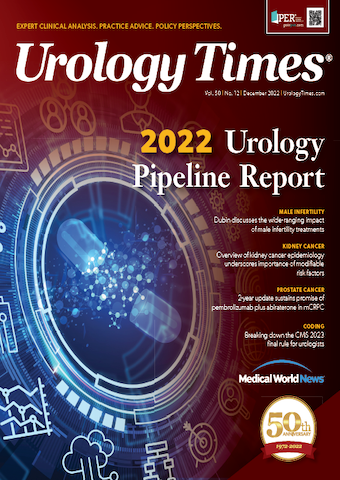Publication
Article
Urology Times Journal
Dr. Dubin discusses male infertility treatments’ wide-ranging impact
Author(s):
In this interview, Justin Dubin, MD, discusses the development of treatments for male infertility.
Justin Dubin, MD

Urology Times® is celebrating its 50th anniversary in 2022. To mark the occasion, we are highlighting 50 of the top innovations and developments that have transformed the field of urology over the past 50 years. In this installment, Justin Dubin, MD, discusses the development of treatments for male infertility. Dubin just completed his andrology fellowship at Northwestern University Feinberg School of Medicine in Chicago, Illinois and will be starting his practice as the Director of Men’s Health at Memorial Healthcare Systems in Hollywood, Florida in the fall.
What are some of the key male infertility treatments that have been developed over the past 50 years?
When we look at the history of male infertility and its treatments, I would argue that almost no other surgical subspecialty within urology has changed as dramatically. Breaking down the key developments, there are really 2 that come to mind. One is the development of in vitro fertilization, IVF, and intracytoplasmic sperm injection, ICSI. These 2 technologies have provided couples who have struggled with fertility and may not have been able to conceive naturally, to have the ability to have biological children and create families.
The second thing that is really important in the field of male infertility is the creation and implementation of the surgical microscope. A large portion of andrological surgery requires operating in very small fields on small parts of the body, and to do surgery well on these parts, obviously, you need to see what you're doing. So the ability to use a microscope has been incredibly important.
Why should these treatments be part of a list of innovations in urology?
When you're thinking about this in pure numbers, about 15% of couples struggle with fertility, and about 50% of the time there is a male factor component involved in the family fertility issue. About 30% of the time, it's strictly a male fertility cause. So when you're talking about "impact," I don't think it gets any bigger than treating male infertility, because you're surgically treating the man, of course, but you're really treating the couple as a whole, and you're helping potentially create a new life. This is not knocking other sub specialties in the field; when you're treating that 1 person, you do have an impact on that person, obviously, and indirectly, you're affecting their family and friends. But when we're talking about male infertility and these advances, we're directly affecting potentially 3 lives: the male patient, their partner, and hopefully the newborn child that results from the treatment. In terms of total impact, IVF and ICSI have probably changed the lives of more people than any technology in urology, and maybe in all surgical and medical specialties. Prior to the first baby being born from IVF in 1978, and the first baby being born through ICSI in the 1990s, for men with nonobstructive azoospermia, their only options for family planning were really donor sperm or adoption. These men were not provided the opportunity to have biological children. But once ICSI was developed, where we had the ability to take a single sperm from the testicle and inject it into a single egg, that completely changed the landscape, and it allowed our patients to have new potential treatment options. Because we only needed 1 sperm, we could surgically go into the testicle, hopefully find sperm in these guys who had production issues, and send it to the lab to create a biological child from our patient. It really allowed the creation of other surgeries like microTESE [microsurgical testicular sperm extraction].
That leads me to the second aspect, which is the creation and the use of the surgical microscope. I mentioned before that a lot of the surgeries that we do involve very small parts of the body, and they're really hard to see without any help. You have the vas deferens, the epididymis, the testicular veins, the testicular arteries, and the seminiferous tubules. Prior to microsurgery, these were being done in a more macroscopic level without good visualization of these structures, and obviously, the success rate wasn't great because of that. But the introduction of the surgical microscope first in the 1970s, with the vasectomy reversal then in the 1980s with the varicocelectomy allowed surgeons to perform a safer, more effective surgery with higher success rates. Then came the microTESE, which was pioneered by Peter N. Schlegel [, MD, FACS], in 1998 in which we use the surgical microscope to selectively look at seminiferous tubules within the testicle to try to identify tubules that are more likely to have sperm. It really changed the game for fertility, especially in men with this production issue. The data have shown that retrieval rates for sperm have been significantly better using this microTESE technology.
How have these treatments improved the lives of men with infertility?
When you ask the most successful people on Earth who are parents what the best thing that they have ever done in their lives is, usually they will say it's becoming a parent and creating a family, despite whatever else they've done. For many men, fatherhood is one of, if not the most important experience of their lives, and to give men the opportunity to be a father, I don't think it gets much better than that.
What future innovations in male infertility treatment do you anticipate over the next several years?
When we're looking at male infertility, there's a lot of room for growth within the field. It's still a field relatively in its infancy. Just to give you an example, we still need to get a better grasp of hormones like FSH and how they relate to male infertility. Hopefully, if we can understand this a little bit better, we can actually help advance the field with new potential medicinal interventions, not just surgical, for fertility treatment.
In terms of technology, however, I think we're starting to see the advancement of and use of 2 new devices: the 4K 3D surgical microscope, as well as robotics for micro surgery. There have been a lot of exciting new techniques and approaches using those technologies. I also think artificial intelligence might be able to help us identify the most likely tubules to have sperm during a microTESE.
One of the really cool things that we're looking at for male infertility actually is not creating life but preserving fertility. Currently, patients who undergo chemotherapy or radiation for cancer are at risk for losing their fertility permanently. This becomes really problematic when you have to treat boys who have not undergone puberty. They can't give a semen sample to bank before they get treatment, and unfortunately, once they are treated with chemotherapy or radiation, they may never have sperm at all. So what are we going to do for them and their future fertility? There’s a really cool program that Kyle Orwig [, PhD], has created. He made a testicular tissue cryopreservation protocol, in which you collect and bank testicular tissue from boys before they get their chemotherapy or radiation therapy in hopes of, in the future, grafting it back onto them after their treatment so that that tissue can later on create sperm for family planning. He's doing a lot of research in it, and he has successfully been able to do this in monkeys. In 2019, he grafted testicular tissue back onto a monkey, and that graft was able to create sperm that was used to create a baby monkey. We're not there yet with humans, but the actual protocol for testicular tissue preservation is underway in anticipation that we can do this in the future. In places like Northwestern, where I'm finishing up now, we do this. We are collecting boys' tissue in hopes of later on preserving their fertility. That's pretty cool stuff.
























